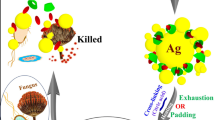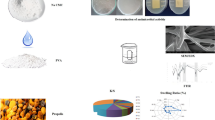Abstract
Topical formulations containing 1–2% of Pinus brutia bark extract and Pycnogenol® have been prepared to investigate the effect of flavonoids on the stability of O/W emulsions, which were subjected to physicochemical and thermal stability tests. The formulations have been applied to cotton fabrics to evaluate antimicrobial properties against Staphylococcus aureus, Escherichia coli, Candida albicans and Aspergillus brasiliensis. Furthermore, prepared cotton fabrics have been tested on keratinocytes seeded in cell culture inserts for wound healing. Results of freeze thaw cycle test indicated enhanced thermo-stability with no major changes in pH and viscosity, likewise the results of centrifugation assay. However, the addition of Pycnogenol® has tremendously decreased the viscosity of the topical formulation (10,900 cp.). In terms of antimicrobial activity, 2% P. brutia treated cotton fabrics decreased the proliferation of Aspergillus brasiliensis 78.8%, which were more effective than that of Pycnogenol® formulation (62.9%). As for wound healing, 2% P. brutia treated cotton fabrics increased HaCaT keratinocyte cell proliferation and accelerated the cell-free gap closure compared to Pycnogenol® and untreated control groups. The obtained results indicate the utilization of pine bark for developing an eco-friendly natural antifungal finish for medical textiles.




Similar content being viewed by others
Data availability
All data generated or analysed during this study are included in this published article.
References
AATCC 100 (2014) Antimicrobial activity assessment of textile materials: parallel streak method from American Association of Textile Chemists and Colorists. https://microchemlab.com/. Accessed 11 Nov 2020
Anchisi C, Maccioni AM, Sinico C, Valenti D (2001) Stability studies of new cosmetic formulations with vegetable extracts as functional agents. IL Farmaco 56:427–431
Blazsó G, Gábor M, Schönlau F, Rohdewald P (2004) Pycnogenol® accelerates wound healing and reduces scar formation. Phytother Res 18:579
Casagrande R, Georgetti SR, Verri WA, Dorta DJ, Santos AC, Fonseca MJV (2006) Protective effect of topical formulations containing quercetin against UVB-induced oxidative stress in hairless mice. J Photochem Photobiol B 84:21–27
Cetin EO, Yesil-Celiktas O, Cavusoglu T, Demirel-Sezer E, Akdemir O, Uyanikgil Y (2013) Incision wound healing activity of pine bark extract containing topical formulations: an investigative study with histopathological and biochemical analyses in albino rats. Pharmazie 68:75–80
Chaniad P, Tewtrakul S, Sudsai T, Langyanai S, Kaewdana K (2020) Anti-inflammatory, wound healing and antioxidant potential of compounds from Dioscorea bulbifera L. bulbils. PLoS ONE 15:e0243632
Cheruku SP, Ramalingayya GV, Chamallamudi MR, Biswas S, Nandakumar K, Nampoothiri M, Gourishetti K, Kumar N (2018) Catechin ameliorates doxorubicin-induced neuronal cytotoxicity in in vitro and episodic memory deficit in in vivo in Wistar rats. Cytotechnology 70:245–259
Coger V, Million N, Rehbock C et al (2019) Tissue concentrations of zinc, iron, copper, and magnesium during the phases of full thickness wound healing in a rodent model. Biol Trace Elem Res 191:167–176
Dong C, He P, Lu Z et al (2018) Preparation and properties of cotton fabrics treated with a novel antimicrobial and flame retardant containing triazine and phosphorus components. J Therm Anal Calorim 131:1079–1087
Elmataeeshy ME, Sokar MS, Bahey-El-Din M, Shaker DS (2018) Enhanced transdermal permeability of Terbinafine through novel nanoemulgel formulation; Development, in vitro and in vivo characterization. Future J Pharm Sci 4:18–28
Er S, Dikmen M (2017) Camellia sinensis increased apoptosis on U2OS osteosarcoma cells and wound healing potential on NIH3T3 fibroblast cells. Cytotechnology 69:901–914
Gressier P, De Smet D, Beharya N, Campagne C, Vanneste M (2019) Antibacterial polyester fabrics via diffusion process using active bio-based agents from essential oils. Ind Crops Prod 136:11–20
Ince I, Yesil-Celiktas O, Karabay-Yavasoglu NU, Elgin G (2009) Effects of P. brutia bark extract and Pycnogenol® in a rat model of carrageenan induced inflammation. Phytomedicine 16:1101–1104
Kazan A, Sevimli-Gur C, Yesil-Celiktas O, Dunford NT (2017) In vitro tumor suppression properties of blueberry extracts in liquid and encapsulated forms. Eur Food Res Technol 243:1057–1063
Kuban-Jankowska A, Kostrzewa T, Musial C, Barone G, Lo-Bosco G, Lo-Celso F, Gorska-Ponikowska M (2020) Green tea catechins induce inhibition of ptp1b phosphatase in breast cancer cells with potent anti-cancer properties: in vitro assay, molecular docking, and dynamics studies. Antioxidants 9:1–12
Landen NX, Li D, Stahle M (2016) Transition from inflammation to proliferation: a critical step during wound healing. Cell Mol Life Sci 73:3861–3885
Lee NR, Lee HJ, Yoon NY, Kim D, Jung M, Choi EH (2016) Application of topical acids improves atopic dermatitis in murine model by enhancement of skin barrier functions regardless of the origin of acids. Ann Dermatol 28:690–696
Li J, Hu L, Zhou T, Gong X, Jiang R, Li H, Kuang G, Wan J, Li H (2019) Taxifolin inhibits breast cancer cells proliferation, migration and invasion by promoting mesenchymal to epithelial transition via β-catenin signaling. Life Sci 232:116617
Lichota A, Gwozdzinski L, Gwozdzinski K (2019) Therapeutic potential of natural compounds in inflammation and chronic venous insufficiency. Eur J Med Chem 176:68–91
Lopez JF, Sarkanen J-R, Huttala O, Kaartinen IS, Kuokkanen HO, Ylikomi T (2018) Adipose tissue extract shows potential for wound healing: in vitro proliferation and migration of cell types contributing to wound healing in the presence of adipose tissue preparation and platelet rich plasma. Cytotechnology 70:1193–1204
Reszko AE, Berson D, Lupo MP (2010) Cosmeceuticals: practical applications. Obstet Gyn Clin N Am 37:547
Said MM, Rehan M, El-Sheikh S, Zahran MK, Abdel-Aziz MS, Bechelany M, Barhoum A (2021) Multifunctional hydroxyapatite/silver nanoparticles/cotton gauze for antimicrobial and biomedical applications. Nanomaterials 11:1–25
Salama AAA, Kotb RM, Shaker RN (2015) Effect of treatment durability and coloration of coated cotton fabrics on antibacterial, UV-blocking, healing and anti-ınflammatory properties. J Chem Pharm Res 7:181–193
Santos PH, Kammers JC, Silva AP, Oliveira JV, Hense H (2021) Antioxidant and antibacterial compounds from feijoa leaf extracts obtained by pressurized liquid extraction and supercritical fluid extraction. Food Chem 344:128620
Shah A, Amini-Nik S (2017) The role of phytochemicals in the inflammatory phase of wound healing. Int J Mol Sci 18:1068
Shen C, Jun H, Choi S et al (2010) Evaluation of antioxidant activities and active compounds separated from water soluble extracts of Korean black pine barks. Bull Korean Chem Soc 31:3567–3572
Shevelev AB, La Porta N, Isakova EP et al (2020) In vivo antimicrobial and wound-healing activity of resveratrol, dihydroquercetin, and dihydromyricetin against Staphylococcus aureus, Pseudomonas aeruginosa, and Candida albicans. Pathogens 9:296
Suntar I, Tumen I, Ustun O, Keles H, Akkol EK (2012) Appraisal on the wound healing and anti-inflammatory activities of the essential oils obtained from the cones and needles of Pinus species by in vivo and in vitro experimental models. J Ethnopharmacol 139:533–540
Wang Y, Li W, Xu S, Hu R, Zeng Q, Liu Q, Li S, Lee H, Chang M, Guan L (2019) Protective skin aging effects of cherry blossom extract (Prunus yedoensis) on oxidative stress and apoptosis in UVB-irradiated HaCaT cells. Cytotechnology 71:457–487
Xu Y, Han M, Huang M, Xu X (2021) Enhanced heat stability and antioxidant activity of myofibrillar protein-dextran conjugate by the covalent adduction of polyphenol. Food Chem 352:129376
Yesil-Celiktas O (2009) A comparative study of antioxidant properties of extracts obtained from renewable forestry and agricultural resources. Fresenius Environ Bull 18:1507–1512
Yesil-Celiktas O, Otto F, Gruener S, Parlar H (2009a) Determination of extractability of pine bark using supercritical CO2 extraction and different solvents—optimization and prediction. J Agric Food Chem 57:341–347
Yesil-Celiktas O, Ganzera M, Akgun IH, Sevimli C, Korkmaz KS, Bedir E (2009b) Determination of polyphenolic constituents and biological activities of bark extracts from different Pinus species. J Sci Food Agric 89:1339–1345
Yesil-Celiktas O, Pala C, Cetin-Uyanikgil EO, Sevimli-Gur C (2017) Synthesis of silica-PAMAM dendrimer nanoparticles as promising carriers in Neuro blastoma cells. Anal Biochem 519:1–7
Acknowledgements
The financial support provided by the Research fund of Ege University (15MUH051) is highly appreciated.
Author information
Authors and Affiliations
Corresponding authors
Ethics declarations
Conflict of interest
The authors declare no conflicts of interest.
Additional information
Publisher's Note
Springer Nature remains neutral with regard to jurisdictional claims in published maps and institutional affiliations.
Rights and permissions
About this article
Cite this article
Secim-Karakaya, P., Saglam-Metiner, P. & Yesil-Celiktas, O. Antimicrobial and wound healing properties of cotton fabrics functionalized with oil‐in‐water emulsions containing Pinus brutia bark extract and Pycnogenol® for biomedical applications. Cytotechnology 73, 423–431 (2021). https://doi.org/10.1007/s10616-021-00467-2
Received:
Accepted:
Published:
Issue Date:
DOI: https://doi.org/10.1007/s10616-021-00467-2




